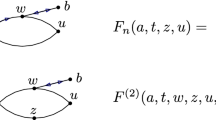Abstract
The contact process and oriented percolation are expected to exhibit the same critical behavior in any dimension. Above their upper critical dimension d c, they exhibit the same critical behavior as the branching process. Assuming existence of the critical exponents, we prove a pair of hyperscaling inequalities which, together with the results of refs. 16 and 18, implies d c=4.
Similar content being viewed by others
REFERENCES
M. Aizenman and D. J. Barsky, Sharpness of the phase transition in percolation models, Commun. Math. Phys. 108:489-526 (1987).
M. Aizenman and C. M. Newman, Tree graph inequalities and critical behavior in percolation models, J. Statist. Phys. 36:107-143 (1984).
D. J. Barsky and M. Aizenman, Percolation critical exponents under the triangle condition, Ann. Probab. 19:1520-1536 (1991).
D. J. Barsky and C. C. Wu, Critical exponents for the contact process under the triangle condition, J. Statist. Phys. 91:95-124 (1998).
C. Bezuidenhout and G. Grimmett, The critical contact process dies out, Ann. Probab. 18:1462-1482 (1990).
C. Bezuidenhout and G. Grimmett, Exponential decay for subcritical contact and percolation processes, Ann. Probab. 19:984-1009 (1991).
C. Borgs, J. T. Chayes, H. Kesten, and J. Spencer, Uniform boundedness of critical crossing probabilities implies hyperscaling, Random Struct. Alg. 15:368-413 (1999).
J. T. Chayes and L. Chayes, On the upper critical dimension of Bernoulli percolation, Commun. Math. Phys. 113:27-48 (1987).
R. Durrett, Lecture Notes on Particle Systems and Percolation (Wadsworth & Brooks/Cole, 1988).
G. Grimmett and P. Hiemer, Directed percolation and random walk, preprint (2001).
T. Hara and G. Slade, Mean-field critical behaviour for percolation in high dimensions, Commun. Math. Phys. 128:333-391 (1990).
T. E. Harris, Contact interactions on a lattice, Ann. Probab. 2:969-988 (1974).
R. van der Hofstad and G. Slade, A generalised inductive approach to the lace expansion, to appear in Probab. Theory Related Fields.
R. van der Hofstad and G. Slade, Convergence of critical oriented percolation to super-Brownian motion above 4+1 dimension, preprint (2001).
T. M. Liggett, Stochastic Interacting Systems: Contact, Voter, and Exclusion Processes (Springer-Verlag, 1999).
B. G. Nguyen and W.-S. Yang, Triangle condition for oriented percolation in high dimensions, Ann. Probab. 21:1809-1844 (1993).
B. G. Nguyen and W.-S. Yang, Gaussian limit for critical oriented percolation in high dimensions, J. Statist. Phys. 78:841-876 (1995).
A. Sakai, Mean-field critical behavior for the contact process, J. Statist. Phys. 104:111-143 (2001).
H. Tasaki, Geometric critical exponent inequalities for general random cluster models, J. Statist. Phys. 49:841-847 (1987).
H. Tasaki, Hyperscaling inequalities for percolation, Commun. Math. Phys. 113:49-65 (1987).
Author information
Authors and Affiliations
Rights and permissions
About this article
Cite this article
Sakai, A. Hyperscaling Inequalities for the Contact Process and Oriented Percolation. Journal of Statistical Physics 106, 201–211 (2002). https://doi.org/10.1023/A:1013197011935
Issue Date:
DOI: https://doi.org/10.1023/A:1013197011935



